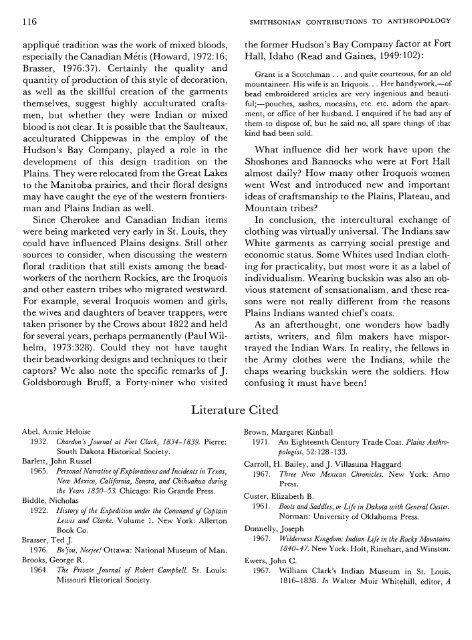Plains Indian Studies - Smithsonian Institution Libraries
Plains Indian Studies - Smithsonian Institution Libraries
Plains Indian Studies - Smithsonian Institution Libraries
You also want an ePaper? Increase the reach of your titles
YUMPU automatically turns print PDFs into web optimized ePapers that Google loves.
116 SMITHSONIAN CONTRIBUTIONS TO ANTHROPOLOGY<br />
applique tradition was the work of mixed bloods,<br />
especially the Canadian Metis (Howard, 1972:16;<br />
Brasser, 1976:37). Certainly the quality and<br />
quantity of production of this style of decoration,<br />
as well as the skillful creation of the garments<br />
themselves, suggest highly acculturated craftsmen,<br />
but whether they were <strong>Indian</strong> or mixed<br />
blood is not clear. It is possible that the Saulteaux,<br />
acculturated Chippewas in the employ of the<br />
Hudson's Bay Company, played a role in the<br />
development of this design tradition on the<br />
<strong>Plains</strong>. They were relocated from the Great Lakes<br />
to the Manitoba prairies, and their floral designs<br />
may have caught the eye of the western frontiersman<br />
and <strong>Plains</strong> <strong>Indian</strong> as well.<br />
Since Cherokee and Canadian <strong>Indian</strong> items<br />
were being marketed very early in St. Louis, they<br />
could have influenced <strong>Plains</strong> designs. Still other<br />
sources to consider, when discussing the western<br />
floral tradition that still exists among the beadworkers<br />
of the northern Rockies, are the Iroquois<br />
and other eastern tribes who migrated westward.<br />
For example, several Iroquois women and girls,<br />
the wives and daughters of beaver trappers, were<br />
taken prisoner by the Crows about 1822 and held<br />
for several years, perhaps permanently (Paul Wilhelm,<br />
1973:328). Could they not have taught<br />
their beadworking designs and techniques to their<br />
captors? We also note the specific remarks of J.<br />
Goldsborough Bruff, a Forty-niner who visited<br />
Abel, Annie Heloise<br />
1932. Chardon's Journal at Fort Clark, 1834-1839. Pierre:<br />
South Dakota Historical Society.<br />
Barlett, John Russel<br />
1965. Personal Narrative of Explorations and Incidents in Texas,<br />
New Mexico, California, Sonora, and Chihuahua during<br />
the Years 1850-53. Chicago: Rio Grande Press.<br />
Biddle, Nicholas<br />
1922. History of the Expedition under the Command of Captain<br />
Lewis and Clarke. Volume 1. New York: Allerton<br />
Book Co.<br />
Brasser, Ted J.<br />
1976. Bo'jou, Neejee/ Ottawa: National Museum of Man.<br />
Brooks, George R.<br />
1964. The Private Journal of Robert Campbell. St. Louis:<br />
Missouri Historical Society.<br />
Literature Cited<br />
the former Hudson's Bay Company factor at Fort<br />
Hall, Idaho (Read and Gaines, 1949:102):<br />
Grant is a Scotchman . . . and quite courteous, for an old<br />
mountaineer. His wife is an Iriquois. . . Her handywork,—of<br />
bead embroidered articles are very ingenious and beautiful;—pouches,<br />
sashes, mocasins, etc. etc. adorn the apartment,<br />
or office of her husband. I enquired if he had any of<br />
them to dispose of, but he said no, all spare things of that<br />
kind had been sold.<br />
What influence did her work have upon the<br />
Shoshones and Bannocks who were at Fort Hall<br />
almost daily? How many other Iroquois women<br />
went West and introduced new and important<br />
ideas of craftsmanship to the <strong>Plains</strong>, Plateau, and<br />
Mountain tribes?<br />
In conclusion, the intercultural exchange of<br />
clothing was virtually universal. The <strong>Indian</strong>s saw<br />
White garments as carrying social prestige and<br />
economic status. Some Whites used <strong>Indian</strong> clothing<br />
for practicality, but most wore it as a label of<br />
individualism. Wearing buckskin was also an obvious<br />
statement of sensationalism, and these reasons<br />
were not really different from the reasons<br />
<strong>Plains</strong> <strong>Indian</strong>s wanted chiefs coats.<br />
As an afterthought, one wonders how badly<br />
artists, writers, and film makers have misportrayed<br />
the <strong>Indian</strong> Wars. In reality, the fellows in<br />
the Army clothes were the <strong>Indian</strong>s, while the<br />
chaps wearing buckskin were the soldiers. How<br />
confusing it must have been!<br />
Brown, Margaret Kinball<br />
1971. An Eighteenth Century Trade Coat. <strong>Plains</strong> Anthropologist,<br />
52:128-133.<br />
Carroll, H. Bailey, and J. Villasuna Haggard<br />
1967. Three New Mexican Chronicles. New York: Arno<br />
Press.<br />
Custer, Elizabeth B.<br />
1961. Boots and Saddles, or Life in Dakota with General Custer.<br />
Norman: University of Oklahoma Press.<br />
Donnelly, Joseph<br />
1967. Wilderness Kingdom: <strong>Indian</strong> Life in the Rocky Mountains<br />
1840-47. New York: Holt, Rinehart, and Winston.<br />
Ewers, John C.<br />
1967. William Clark's <strong>Indian</strong> Museum in St. Louis,<br />
1816-1838. In Walter Muir Whitehill, editor, A

















